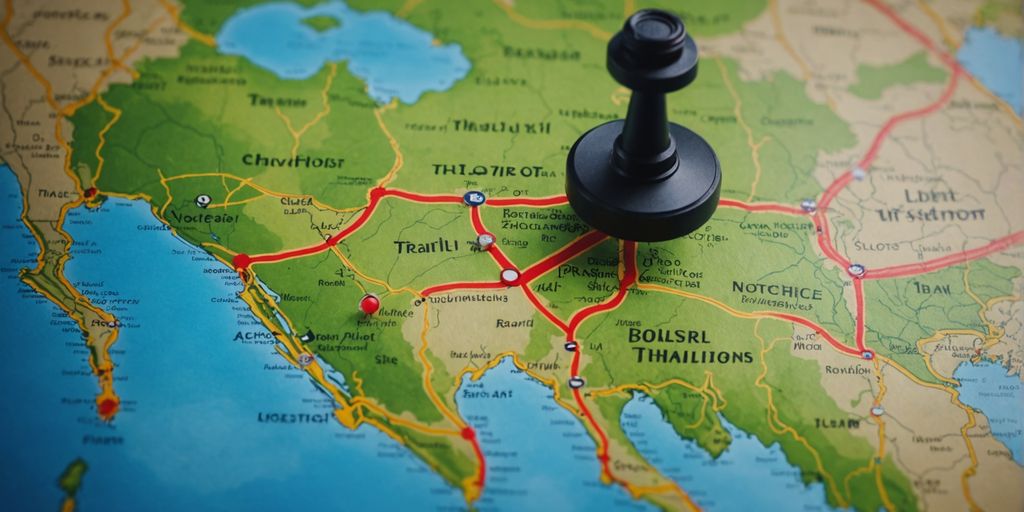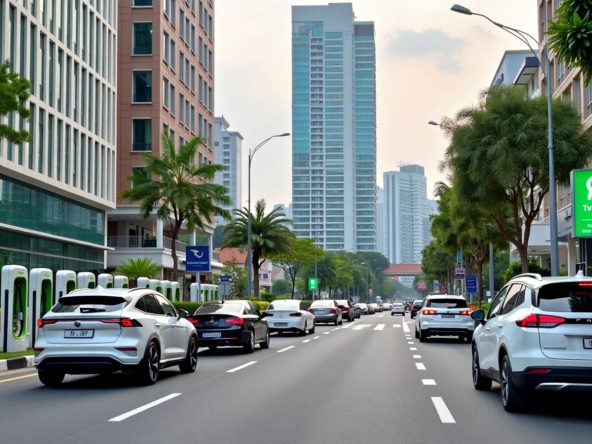Thailand offers a diverse range of living experiences, from bustling cities to quiet rural areas. The cost of living in Thailand varies greatly depending on your location, lifestyle, and personal choices. This article will explore the different factors that influence the cost of living in various parts of Thailand, comparing urban and rural areas, tourist destinations, and more. We’ll also look at how living costs in Thailand stack up against those in Western countries.
Key Takeaways
- The cost of living in Thailand can vary widely based on location, with urban areas like Bangkok being more expensive than rural regions.
- Tourist destinations in Thailand often have higher living costs due to increased demand for accommodations and amenities.
- Housing costs in major Thai cities such as Bangkok, Chiang Mai, and Phuket differ significantly, with Bangkok generally being the most expensive.
- Monthly expenses for a family in Thailand include housing, food, and transportation, which can vary based on lifestyle and location.
- Comparing the cost of living in Thailand to Western countries reveals that Thailand is generally more affordable, though some items like imported goods can be pricier.
Regional Variations in the Cost of Living in Thailand
Urban vs. Rural Areas
Living in urban areas like Bangkok and Chiang Mai generally costs more than in rural regions. This is due to higher demand for housing and other essentials. For instance, a luxury 2 bed seaview condo in Kata will be more expensive than a similar property in a less popular area.
Tourist Destinations
Regions near tourist attractions, such as beach towns and resorts, often have higher living costs. The demand for vacation rentals and tourist amenities drives up prices. For example, living in Phuket or Samui can be pricier due to the influx of tourists.
Local Economic Factors
Local economic conditions also play a role in the cost of living. Areas with thriving economies may have higher costs due to better job opportunities and higher wages. Conversely, regions with less economic activity might be more affordable.
It’s crucial to consider the specific location and regional factors when evaluating the cost of living in Thailand, as these can significantly impact your budget and lifestyle.
Cost of Housing in Major Thai Cities

Bangkok
Bangkok, the bustling capital of Thailand, offers a wide range of housing options. Rental prices for a one-bedroom apartment in the city center can range from INR 25K to INR 50K per month. The cost varies depending on the neighborhood and the type of property. For those looking for more luxurious accommodations, there are numerous high-end apartments and condos available.
Chiang Mai
Chiang Mai, known for its rich culture and scenic beauty, provides more affordable housing compared to Bangkok. A one-bedroom apartment in the city center typically costs between INR 15K and INR 30K per month. The lower cost of living makes Chiang Mai a popular choice for expats and retirees.
Phuket
Phuket, a famous tourist destination, has a diverse housing market. Rental prices for a one-bedroom apartment in the city center range from INR 20K to INR 40K per month. The Phuket Real Estate Market also offers a variety of options, including Luxury Villas For Sale. For instance, Ocean Worldwide presents magnificent 2-bedroom pool villas in Kamala. Explore properties in Phuket, Samui, and more. Buy, rent, sell, and list your property with ease.
The cost of housing in major Thai cities can vary significantly based on location, property type, and proximity to tourist attractions. It’s essential to consider these factors when planning your budget.
| City | Rent (1-bedroom apartment) |
|---|---|
| Bangkok | INR 25K – INR 50K |
| Chiang Mai | INR 15K – INR 30K |
| Phuket | INR 20K – INR 40K |
The housing market in Thailand offers something for everyone, from affordable apartments to luxurious villas. Whether you’re looking to rent or buy, it’s crucial to research and understand the local market conditions.
Monthly Expenses for a Family in Thailand
Housing Costs
Housing costs in Thailand can vary greatly depending on the location and type of property. For a two-bedroom home, you might expect to pay around $600 per month in rent. Property ownership is another option, but it comes with its own set of costs and regulations.
Food and Groceries
Food expenses can also differ based on lifestyle choices. On average, a family might spend about $180 per month on groceries. Dining out can add to this cost, with local restaurants being more affordable than international ones.
Transportation
Transportation costs are relatively low in Thailand. A family might spend around $15 per month on local transportation. However, owning a private vehicle will increase this expense due to fuel and maintenance costs.
Living in Thailand offers a lower cost of living compared to many Western countries, but expenses can add up depending on lifestyle and location.
Here’s a sample monthly budget for a family living in Thailand:
| Expense Category | Monthly Cost (USD) |
|---|---|
| Rent | $600 |
| Electricity | $90 |
| Water | $6 |
| Gas | $35 |
| Household Help | $27 |
| Internet | $12 |
| Cellphone | $12 |
| Pay TV | $12 |
| Health Care | $400 |
| Transportation | $15 |
| Groceries | $180 |
| Entertainment | $200 |
| Miscellaneous | $100 |
| Total | $1689 |
Comparing the Cost of Living in Thailand to Western Countries

When comparing the cost of living in Thailand to that of Western countries, it’s important to keep in mind that there are a number of factors that can impact the overall cost of living, including the specific location within Thailand or the Western country, the cost of housing and other necessities, and personal lifestyle choices.
United States
Generally speaking, the cost of living in Thailand is lower than in many Western countries, especially when it comes to necessities like housing and food. For example, the average cost of rent in Thailand is lower than in countries like the United States, Canada, and Australia, while the cost of groceries and dining out is also generally lower.
United Kingdom
However, there are also some areas where the cost of living in Thailand may be higher than in Western countries, such as the cost of imported goods and luxury items. Additionally, the cost of healthcare and insurance may be higher in Thailand than in some Western countries.
Australia
Overall, the cost of living in Thailand can vary widely depending on your location, lifestyle, and personal preferences, so it’s important to carefully consider your budget and what you’re willing to spend when comparing the cost of living in Thailand to that of Western countries.
Utility Costs in Thailand
Electricity
Electricity costs in Thailand can vary widely based on location, property size, and usage. For a one-room studio apartment, you might pay around $40 per month, while a larger four-bedroom villa could see costs as high as $300 per month. The tropical climate means frequent use of air conditioning, which can significantly increase your electricity bill. On average, electricity rates are about ฿3.99 per kWh.
Water
Water is relatively inexpensive in Thailand. Monthly costs typically range from ฿100 to ฿200, depending on usage. The rate per unit of water is between ฿10.20 and ฿21.20. Despite occasional power cuts in some cities, a constant supply of water is generally available.
Internet and Mobile Services
Thailand offers affordable internet and mobile services. A 60 Mbps broadband connection costs about INR 1,200 per month, making it one of the more economical options in Southeast Asia. Mobile service packages are also reasonably priced, with various plans to suit different needs.
Utility costs in Thailand are generally lower than in many Western countries, making it an attractive destination for both long-term residents and those seeking short term rentals.
Healthcare Costs in Thailand
Public Healthcare
Thailand’s public healthcare system offers high-quality medical care at lower costs compared to most Western countries. However, long queues are common, and the system does not extend to expats. For non-citizens, visiting a private hospital is often the best option.
Private Healthcare
A visit to a private hospital can range from $43.14 to $86.29. If admitted, the cost for a standard room can go up to $287.64 per night, while an ICU stay can reach $2,876.70. Despite the affordability, costs can add up quickly. Therefore, investing in travel insurance is advisable. For those under the long-term resident (LTR) program, proof of health insurance coverage worth at least $50,000 is required.
Health Insurance
Health insurance is not mandatory but highly recommended, especially if not covered by an employer. A good policy typically costs between $100 and $200 per month, depending on age and coverage needs.
Medical emergencies can be another significant cost. While minor ailments can be treated cheaply at local pharmacies, serious issues require hospital visits. For example, a basic consultation at Bangkok Hospital costs around $30, and an MRI scan is approximately $250.
Cost of Education in Thailand
Public Schools
Public schools in Thailand are free for both Thai and foreign students. However, most of these schools teach in Thai and do not offer an English-language curriculum. This makes them less suitable for many expat families.
Private Schools
Private schools in Thailand offer a more diverse curriculum, often including English-language programs. The cost for private schooling can range from ฿100,000 to ฿500,000 per year, depending on the institution and the level of education.
International Schools
International schools are the most expensive option, with fees that can go up to $30,000 per year. These schools offer international curricula such as the International Baccalaureate (IB) or the British curriculum, making them a popular choice for expat families. These schools provide a high standard of education but come at a premium price.
For families considering short term rentals in Thailand, it’s important to factor in the cost of education, especially if opting for private or international schools.
Transportation Costs in Thailand
Public Transport
In Thailand, it is possible to get by without owning a car. The public transportation system is fairly extensive, and while it may not be the most efficient way to get around, it is certainly the most affordable. Buses in Thailand are modern, air-conditioned, and comfortable. They are also very cheap, with prices ranging from 7-30 THB per journey (US$0.20-0.85), depending on the distance traveled. You can either buy tickets at the bus station or on the bus itself.
Private Vehicles
Owning a car in Thailand can be more expensive due to the costs of fuel, maintenance, and insurance. However, for those who prefer the convenience and comfort of a private vehicle, it is a viable option. Motorbike taxis are another popular choice, especially for short distances. They are faster than buses and can navigate through traffic more easily.
Ride-Sharing Services
Ride-sharing services like Grab are widely used in Thailand. They offer a convenient and often more comfortable alternative to traditional taxis. Prices can vary depending on the distance and time of day, but they are generally affordable. Tuk-tuks, small three-wheeled vehicles, are also a popular choice for short trips and offer a unique transportation experience. Prices can vary widely, from $5 to $50, depending on the distance traveled and the negotiation skills of the passenger.
Generally, public transport in Thailand will be cheaper than in many other countries, though service levels and ease of use can vary.
Cost Comparison
| Mode of Transport | Cost Range (THB) | Cost Range (USD) |
|---|---|---|
| Bus | 7-30 | 0.20-0.85 |
| Taxi | 35+8/km | 1+0.20/km |
| Tuk-tuk | 150-1500 | 5-50 |
| Grab | Varies | Varies |
In summary, Thailand offers a variety of transportation options to suit different needs and budgets. Whether you choose public transport, a private vehicle, or a ride-sharing service, you can find a mode of transport that fits your lifestyle and budget.
Cost of Living in Popular Expat Areas
Bangkok
Bangkok, the bustling capital of Thailand, is a top choice for many expats. The cost of living here can vary greatly depending on your lifestyle. For instance, renting a two-bedroom apartment in a central area can cost around $1,000 per month. However, if you opt for a place further from the city center, you might find something for as low as $500. Expats often enjoy the vibrant street food scene, which is both delicious and affordable. A meal at a local restaurant can cost as little as $2.
Chiang Mai
Chiang Mai, known for its relaxed atmosphere and beautiful mountains, is another popular destination for expats. The cost of living here is generally lower than in Bangkok. Renting a similar two-bedroom apartment in Chiang Mai can cost around $600 per month. The city is also known for its numerous markets where you can buy fresh produce at very reasonable prices. Many expats find that their monthly expenses, including rent, food, and transportation, can be comfortably managed on a budget of $1,200.
Pattaya
Pattaya, famous for its beaches and nightlife, attracts many expats looking for a lively environment. The cost of living in Pattaya is somewhat in between Bangkok and Chiang Mai. Renting a two-bedroom apartment near the beach can cost around $800 per month. The city offers a wide range of dining options, from street food to high-end restaurants. A meal at a mid-range restaurant might cost around $10. Additionally, Pattaya is known for its numerous entertainment options, which can add to the overall cost of living.
Living in popular expat areas in Thailand offers a mix of affordability and quality of life. Whether you prefer the hustle and bustle of Bangkok, the serene environment of Chiang Mai, or the vibrant nightlife of Pattaya, there’s something for everyone.
| City | Rent (2-bed apt) | Meal Cost (local) | Monthly Budget |
|---|---|---|---|
| Bangkok | $1,000 | $2 | $2,670 – $3,288 |
| Chiang Mai | $600 | $2 | $1,200 |
| Pattaya | $800 | $10 | $1,500 – $2,000 |
Expats often indulge in small holidays and stay-cations, which can add around $400 to their monthly expenses. This allows them to explore nearby attractions and enjoy the local culture without breaking the bank.
Grocery and Dining Costs in Thailand
Local Markets
Local markets in Thailand offer fresh produce at competitive prices, making it easier to keep your food expenses within budget. For instance, a kilogram of bananas can cost between ฿20 and ฿90, while a kilogram of chicken fillets ranges from ฿45 to ฿177. Buying groceries, which can cost around $180 per month, is a great way to keep your overall cost of living low.
Supermarkets
Supermarkets in Thailand provide a wide range of products, including imported goods, which can be more expensive. Essential items like a loaf of fresh bread can cost between ฿32 and ฿100, and a liter of milk ranges from ฿42 to ฿95. Expats often find that groceries are generally quite affordable compared to places like London or New York.
Restaurants
Thailand boasts an incredible food culture, from humble streetside stalls to international fine-dining restaurants. A cappuccino in expat neighborhoods can cost around $3.50, while local spots may offer it for less. Dining out is generally affordable, making it a popular choice for both locals and expats.
Despite the differences in prices, overall grocery costs remain manageable, especially when shopping at local markets.
Entertainment and Leisure Costs in Thailand
Gyms and Fitness Centers
Staying fit in Thailand is affordable. A monthly gym membership can cost around 1,000 baht, which is about 30 USD. This is enough to cover a month’s worth of gym membership fees. Many gyms offer modern equipment and various classes, making it easy to maintain a healthy lifestyle.
Cinemas and Theaters
Watching movies in Thailand is a popular pastime. A ticket to a standard cinema costs between 150 to 250 baht. For a more luxurious experience, some theaters offer luxury seating and additional services at a higher price. These options provide a comfortable and enjoyable movie-watching experience.
Tourist Attractions
Thailand is home to numerous tourist attractions, from ancient temples to beautiful beaches. Entry fees to these sites can vary. For example, visiting a famous temple might cost around 50 baht, while access to a national park could be higher. Beach towns and resorts may have higher costs due to the demand for vacation rentals and tourist amenities. However, many attractions are free or very affordable, allowing you to explore the country’s rich culture and natural beauty without spending too much.
Thailand offers a wide range of entertainment options that cater to different budgets, making it possible to enjoy your free time without breaking the bank.
Best Beach Villas
For those looking for a more luxurious experience, Thailand offers some of the best beach villas. These properties provide stunning ocean views and top-notch amenities. Whether you are looking to buy, rent, or sell, there are personalized search options available to find the perfect luxury villa in Thailand.
Thailand offers a variety of entertainment and leisure activities that won’t break the bank. From exploring the vibrant nightlife in Phuket to relaxing on the serene beaches of Samui, there’s something for everyone. Want to know more about the best spots and how to make the most of your trip? Visit our website for detailed guides and tips!
Conclusion
In summary, the cost of living in Thailand varies greatly depending on the region. Urban areas like Bangkok and Chiang Mai tend to be more expensive due to higher demand for housing and amenities. On the other hand, rural areas and smaller towns offer a more affordable lifestyle. Tourist hotspots, such as beach towns, also see higher costs due to the influx of visitors. When planning to live in Thailand, it’s crucial to consider these regional differences to manage your budget effectively. Overall, Thailand offers a range of living costs that can suit different lifestyles and preferences.




